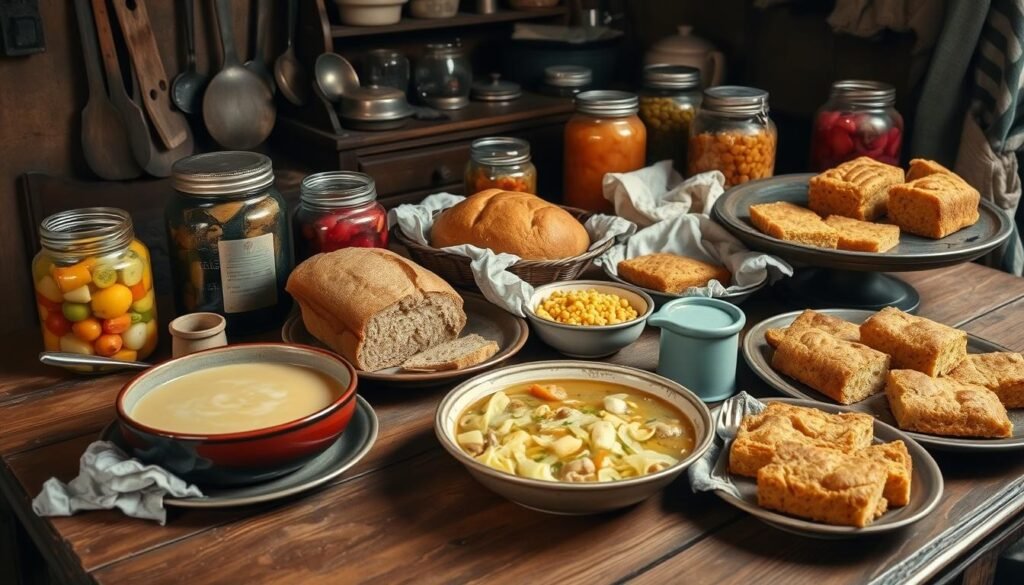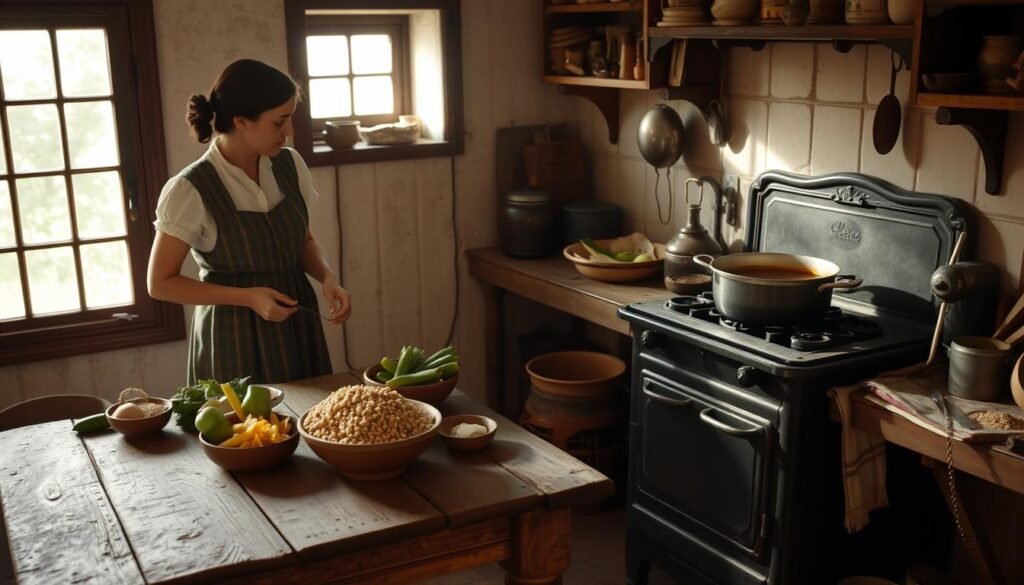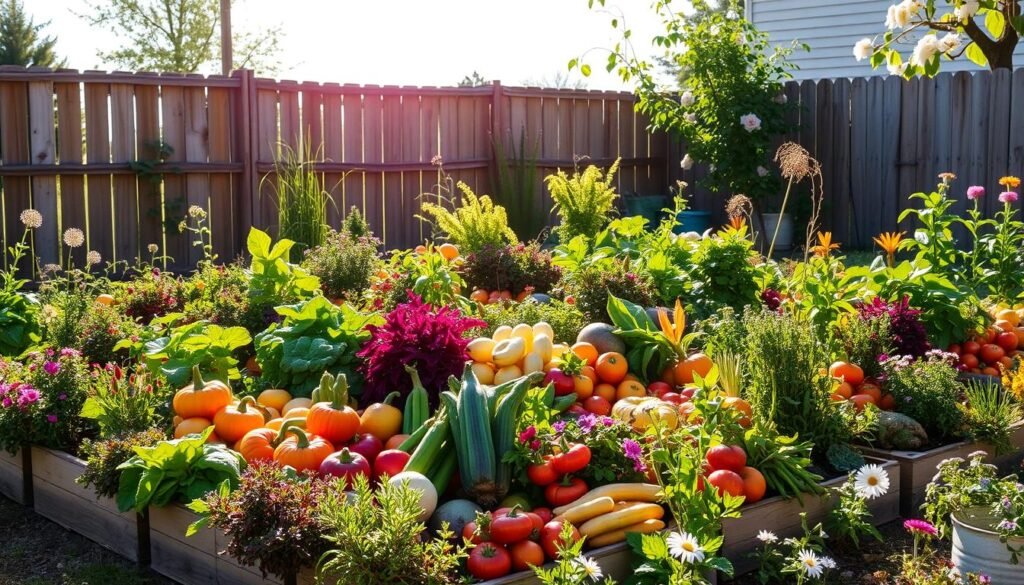Did you know refrigerator ownership in the U.S. sharply rose during the Great Depression? It jumped from 8% to almost 50%. This change shows how the 1930s economic hardships deeply impacted American families and their food habits. During these tough times, saving money on food was crucial. This led to the creation of many budget-friendly recipes that are still loved today.
We’re here to explore how depression era food made its mark. We’ll look at the kinds of food that were popular, the inventive ways people cooked, and how creativity and strength turned simple meals into something special. This peek into the past will show how these hard times changed American cooking for good. You’ll see how they paved the way for the way we cook and eat now.
Key Takeaways
- Economic challenges led to increased refrigerator ownership, highlighting the value of food preservation.
- Rationing and frugality during the Great Depression inspired countless creative recipes.
- Limited resources emphasized the importance of home economics in meal planning.
- Many classic recipes we cherish today originated during the Great Depression era.
- Nutrition was often compromised due to subsistence diets, with many experiencing deficiencies.
- Frugal cooking techniques from the past can still be applied in today’s kitchens for budget-friendly meals.
The Impact of the Great Depression on American Cuisine
The Great Depression changed American food a lot. As unemployment hit 25 percent, families had to shift their diets. They couldn’t afford meat, dairy, and eggs. So, they turned to cheap foods like potatoes, beans, and grains.
In cities like New York, breadlines and soup kitchens became common. They served about 85,000 meals a day. Food brought people together, showing the power of sharing in tough times.
Simple and smart recipes became popular. Take Peanut Butter Bread, for example. It needed only six ingredients. And there was Mulligan Stew, made with whatever was on hand.
This era’s cooking has influenced today’s food talks. Even though we now have easy access to sugar and coffee, food security is still a big issue. Did you know that in 2014, 14 percent of American homes struggled with food security?
The creative dishes from back then showed how strong people can be. Many cooks today explore these recipes, appreciating their history and the strong will behind them.
Want to know more about food during the Great Depression and its effect on today’s cuisine? Check out this great article on Great Depression foods.
Understanding Depression Era Food
The Great Depression changed American food in a big way. It led to what’s known as depression era food. This cooking style is all about being simple and smart with what you have.
Definition and Characteristics of Depression Era Food
Depression era food was made during tough economic times, around 1929 to the late 1930s. Families had to change how they cooked to feed everyone with little. The key parts of this cuisine include:
- Use of inexpensive ingredients such as grains, beans, and root vegetables.
- Emphasis on frugal cooking techniques that stretched food supplies.
- Innovation in recipe creation, often incorporating leftover ingredients.

Back then, dishes like potato soup and simple pasta were common. For example, spaghetti with boiled carrots and a white sauce showed how to be frugal yet creative. These meals were about feeding families well without spending too much.
The Role of Home Economics
During the Great Depression, learning how to cook efficiently was crucial. Home economics taught people key cooking skills. They learned things like:
- Meal planning to maximize nutrition while staying within budget.
- Food preservation techniques like canning and pickling.
- Creative ways to repurpose leftover food to minimize waste.
This focus on useful skills helped fight hunger and kept families healthy. By mastering these methods, people became better at overcoming difficulties. These lessons in cooking remained essential until the economy improved.
Frugal Cooking Techniques from the 1930s
The 1930s were tough times for families because of economic struggles. Home cooks had to be smart with their ingredients, making meals that were cheap but tasty. They found creative ways to use what they had and made sure no one went hungry.
Stretching Ingredients for Budget-Friendly Meals
Families turned to cheap staples like beans and oats during this time. Beans were a go-to because they were full of protein and didn’t need to stay cold. Oats were added to many recipes, like soups and desserts, making the food go further.
Some dishes became really popular because they were not only yummy but also saved money:
- Meatloaf, with oats and veggies mixed in, was a meal many loved.
- Vegetable soups were made from leftovers, transforming scraps into something delicious.
- Cooks used other flours like cornmeal instead of costly wheat flour.
Rationing Recipes that Made a Difference
The Great Depression meant families had to be clever with their meals because of rationing. Home cooks made dishes that were full of taste but used less. A good example is Hobo Stew, which included whatever ingredients were available, showing true kitchen creativity.
They even made desserts like “Depression Cake” with very little sugar, butter, and eggs. Instead of sugar, they used things like molasses, showing their knack for making the best out of a bad situation.
| Ingredient | Common Uses | Benefits |
|---|---|---|
| Beans | Soups, stews, and salads | High in protein, economical, no refrigeration needed |
| Oats | Meatloaf, baked goods, and soups | Adds bulk, enhances filling capacity |
| Alternative Flours | Baking and thickening | Utilizes inexpensive grains, caters to variety in meals |

Victory Gardens: Growing Your Own Food
During the Great Depression, victory gardens were key for many American families. These gardens provided much-needed food, while promoting resilience and self-sufficiency. They became essential in dealing with food shortages and high costs, helping families manage their food supply better.
The Importance of Home-Grown Produce
Victory gardens played a huge role in household food security. Families could grow their own veggies, cutting down on grocery costs. This not only saved money but ensured access to fresh, healthy food. The gardens also encouraged sustainable living, a practice still valued by those wishing to reconnect with where their food comes from. An impressive half of American families grew victory gardens during World War II, producing about 8 million tons of food.
Common Vegetables and Their Uses
Victory gardens featured a variety of vegetables. Families grew what they needed for their meals.
- Potatoes – Versatile and filling, perfect for soups, fries, and casseroles.
- Carrots – Ideal for roasting, stews, or as a fresh snack.
- Onions – Key for flavoring dishes and can be stored long-term.
- Cabbage – Works well in salads, soups, or fermented dishes.
These root vegetables were not only easy to store but also were the basis of countless recipes. Cooking with vegetables from your own garden brought a special pride. Meals were flavorful and nourishing.

| Vegetable | Common Uses | Nutritional Benefits |
|---|---|---|
| Potatoes | Soups, Fries, Casseroles | Rich in Vitamin C and Potassium |
| Carrots | Roasted, Stews, Fresh Snack | High in Fiber and Vitamin A |
| Onions | Flavoring, Pickling | Contains Antioxidants, Good for Heart Health |
| Cabbage | Salads, Soups, Fermented Dishes | Rich in Vitamin K and Fiber |
Victory gardens brought communities together in hard times. They were more than just a way to produce food. They taught responsibility and helped people connect with nature, lessons that are still important today.
Popular Recipes from the Great Depression
The Great Depression led to innovative cooking. Families discovered recipes that were cheap yet filling. Soup kitchens became key, offering food and influencing how people cooked. These places showed the value of making large, affordable meals. Their recipes were about being thrifty, hearty, and clever. Today, we still enjoy these dishes.
Soup Kitchens and Their Influence on Cooking
Soup kitchens were vital during the Great Depression. They helped many families get by. Meals shared here brought people together, making everyone feel part of a community. Families would recreate these simple, nutritious dishes at home. Ingredients like potatoes and beans were common, making these meals a staple for many.
Recipes to Try: From Potato Soup to Hobo Stew
Some recipes from back then are still loved today. The Best Ever Potato Soup, for example, is both delicious and simple. It has 250 calories per serving and packs 13g of fat and 12g of protein. Another favorite, Hobo Stew, is about using whatever you have. These dishes show that being frugal can also be tasty and fulfilling.
Here are some classic Great Depression era recipes:
| Recipe Name | Calories (per serving) | Fat (g) | Protein (g) | Average Cost |
|---|---|---|---|---|
| Potato Soup | 250 | 13 | 12 | $3-$5 |
| Navy Beans and Ham Soup | 244 | 2 | 18 | $3-$4 |
| Hobo Stew | Approx. varies | Varies | Varies | Low cost, ingredients depend |
| Country Fish Chowder | 250 | 12 | 15 | $3-$5 |
For more recipes and their stories, check out this collection of Great Depression recipes. They continue to inspire cooks today.
Meatless Meals and the Emphasis on Vegetables
During the Great Depression, families had tough economic times. This led them to discover the value of meatless meals. Vegetables became the heart of their food due to being cheap and filling. Things like potatoes and beans turned into key ingredients in kitchens. These foods were easy to get and helped make meals that were both healthy and hearty.
Common Ingredients: Root Vegetables and Beans
Root veggies and beans were crucial for those living in this time. Staples like potatoes, carrots, and onions laid the foundation for many dishes. Protein came from lentils, chickpeas, and beans. These could be kept for a while, making sure something was always there to cook with. Through creativity, these simple foods became tasty dishes everyone enjoyed.
Creating Flavorful Dishes without Meat
Creative vegetarian recipes became popular since meat was often skipped. Spices and herbs played a big role in making these dishes exciting. Think about tasty veggie stir-fries, baked bean casseroles, and fresh dandelion salads. These salads are getting popular again because they’re really healthy. Choosing these meatless options helped families eat well without spending a lot. Discover more about Depression-era cooking and how it influences what we eat today.
| Ingredient | Nutritional Benefits | Common Uses |
|---|---|---|
| Potatoes | High in vitamin C and potassium | Soups, casseroles, mashed |
| Carrots | Rich in beta-carotene and fiber | Salads, stews, roasting |
| Beans | Excellent source of protein and iron | Soups, salads, and side dishes |
| Lentils | High in protein and low in fat | Curries, salads, stuffing |
| Dandelion greens | Contains vitamins A, C, K, and E | Salads, sautéing, garnishes |
Food Preservation Techniques Used During the Depression
During the Great Depression, families found ways to keep food through tough times. Canning and pickling were key to save seasonal produce. These methods captured peak freshness of fruits and veggies. This led to popular recipes for pickled cucumbers and canned tomatoes. Families learned to make tasty, enduring food to last all year.
Canning and Pickling Essentials
Canning became a go-to method to store fresh produce during the Depression. Families would aim to fill 200 to 300 jars with vegetables. They planned to eat at least two quarts of vegetables and a quart of fruit daily for a year. Moving to modern jars with screw-top lids was a big improvement in keeping food safe.
Storing Food for Long-Term Survival
Long-term storage was crucial during tough economic times. Families used drying, fermenting, and making preserves to keep their food supplies up. These methods helped them handle food scarcity. The tricks they developed are still used today. People are now preserving apples and tomatoes from their gardens, showing these old methods still matter.
The Legacy of Depression Era Food Today
The lessons from depression era food still touch our lives today. This tough time taught us to cook using everything and waste nothing. These lessons help us make simple, creative meals. They show how to value what we have.
Lessons We Can Learn from the Past
The past teaches us a lot about eating well on less. People back then used every bit of food carefully. They showed us how to enjoy what’s local and fresh. Today, we’re learning to eat with mindfulness, just like they did. This means choosing foods that are good for us, without going over the top. You can learn more about this approach to eating here.
Modern Adaptations of Classic Recipes
Old recipes are coming back with a new twist. Chefs are mixing the old ways with new, healthier ingredients. For example, they’re making dishes like mock apple pie and navy bean soup with better stuff. This keeps the dishes affordable but makes them taste and feel new.
| Classic Recipe | Modern Adaptation | Key Ingredients |
|---|---|---|
| Mock Apple Pie | Mock Apple Pie with Organic Apples | Organic apples, cinnamon, whole grain crust |
| Navy Bean Soup | Vegetarian Navy Bean Soup with Fresh Herbs | Navy beans, vegetable stock, fresh parsley |
| Peanut Butter Cookies | Gluten-Free Peanut Butter Cookies | Natural peanut butter, almond flour, honey |
| Vinegar Pie | Vegan Vinegar Pie | Apple cider vinegar, coconut milk, cane sugar |
Conclusion
Looking into depression era food uncovers a rich culinary heritage. It shapes American cooking even today. During tough times, people became creative and smart in their kitchens. They started practices that were cheap yet effective.
This history teaches us how families managed with less. They invented new cooking methods and used all ingredients. These stories from the Great Depression teach us important lessons.
Keeping these recipes alive shows respect for those who lived through hard times. It keeps their wisdom current. Growing Victory Gardens and using ingredients wisely does more than change our cooking. It deepens our connection to our history.
It shows us how past practices can inspire us today. They encourage us to explore our roots while meeting today’s needs and tastes.
Taking care of our mental health is very important. Mindful practices and eating well can help strengthen our emotional health. They are as useful today as resourceful cooking was in the past.
For tips on better mental health and self-care, check out this wellness guide. It’s a great resource for tackling current challenges.